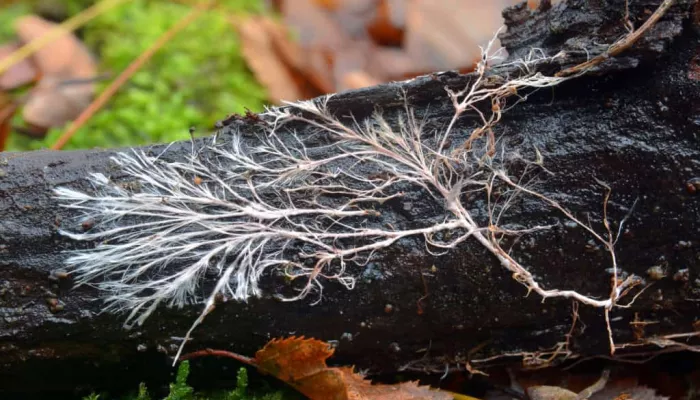Volunteer Matt Huggins explores the underground secrets of mycorrhizal networks and how they help trees to communicate with one another.
Can you keep a secret? Trees can talk. No, really! Perhaps not in the same way as you and I, but just below the forest floor hides a teeming network, linking the woodland’s trees together into one, glorious, communicating community.
I am certainly no biologist and will keep this simple, but first – the science! This Wood Wide Web was first theorised way back in the 1800s and in the intervening years a large amount of research has been dedicated to discovering more about this incredible adaptation. These hidden threads of communication are formed by a network of mycorrhizal fungi, which spread through the woods and forests only a little below the surface. As they approach the base of the trees, they inevitably come across their great roots amongst the earth. As the fungi continues to spread, it attaches itself to the roots, where it lives alongside an abundance of ‘root hairs’. These tiny threads contain high levels of ‘mitochondria’, which is what allows such effective information transfer and links the woods together into one cohesive unit.
As you might imagine, with trees being such stoic individuals, this network is not there just so that they can have a natter about the goings on of squirrels. This ability to communicate far and wide comes with several evolutionary advantages. Firstly, through chemical signals and electrical pulses, the trees are able to share information with their neighbours concerning any sign of drought, increase in insects or spreading disease, which can then be relayed forest wide. As a result, the woodland can adapt its growth and behaviour accordingly, in order to increase its chances of survival through even the most trying of times.
A second advantage of the mycorrhizal network is the sharing of resources, including water, carbon, nitrogen and phosphorus, as well as other minerals. The larger, healthier trees are able to send these important resources from themselves, through the web and to younger, more in need individuals, promoting healthy growth forest wide. Very interestingly, whilst trees will generally share with every other tree in their area, studies have found that they have also shown to favour individuals who share a close relation to themselves. Thanks to the way their seed is dispersed, many of their offspring grow within a close radius. “Mother Trees”, the large, matriarchs of the woods, have been shown to send more carbon to those saplings closely related to them, greatly increasing their chances of survival. Not that they completely ignore the other trees (they seem to naturally understand the importance of a biodiverse environment), but they certainly favour members of their own family – it’s simply the same evolutionary instinct that flows through every living thing.
Even in death, trees look out for the next generation. Further studies have indicated that factors such as injury or disease (or anything that presents a suddenly uncertain future) can trigger them to rapidly increase the rate of mineral transfer through the mycorrhizal network to their family and wider woodland. In preparation for their death, the trees pass on their lifeforce to their offspring, to help them continue in the years ahead even after they themselves are gone– it's beautiful. However, one particularly fascinating example showed how it is not always so straightforward. The large stump of a long gone tree was identified in the midst of a forest, and despite it not growing a single leaf in centuries after being felled almost half a millennium previously, when the surface was scratched away, it was found that the old tree was somehow still alive, with the fresh green of life growing inside. Seemingly unwilling to abandon their elderly relative, the surrounding trees had been pumping nutrients into the old stump the whole time. This seems to demonstrate, at least in some form, a serious sense of family connection between groups of related trees.
Unbelievable maybe, but all none the less true for that. Today, research continues to look deeper into this fascinating area of study. It is now believed that in addition to the Wood Wide Web, the planet’s trees also communicate through the air using scent signals, as well as by omitting noises through the grounds via their roots, at a frequency too low to be heard by the human ear. Isn’t nature wonderful? Our trees are very much alive and aware of their surroundings, part of an active and ancient community capable of caring for family members and the woodlands as a whole. Not only do they share information to aid survival, but, on some level, even appear to be aware of their own mortality. Perhaps we humans have more in common with trees than we first thought…

Save our Woodlands
Development, disease, pollution, and climate change are pushing UK woodlands to crisis point, and threatening the plants and animals that depend on them. By supporting our Save our Woodlands Appeal today you can help us to save woodlands that are at risk, and manage the invaluable woodlands already under our protection – ensuring they remain alive with the sound of nature.

